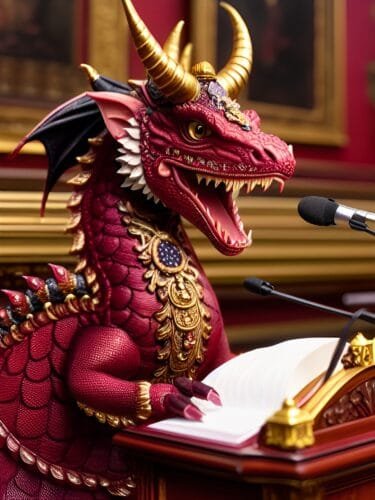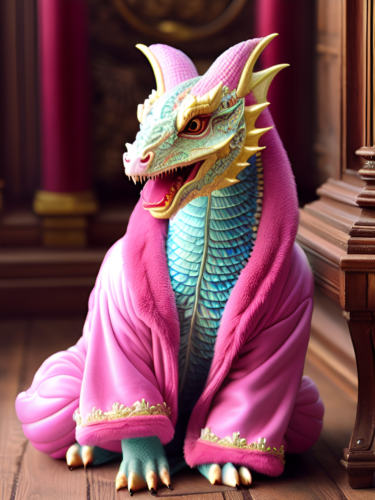Impertinence and Impropriety: The Role of Dragon Voices in Jane Austen’s World

Generally, I like to keep all things author-ly light and fun. Way back in the dark ages, high school English felt rather traumatic, and very, very dark (Thomas Hardy, I’m looking squarely at you!) I don’t pretend to any great literary aspiration, but I do love story nearly as much as I love sociology and the study of culture. Occasionally, someone asks me to speak about the more scholarly aspects of writing and Austen, like the Jane Austen Summer Program did this year. So, I shed my fuzzy pink bathrobe and adorn myself in grown-up clothes to address more serious matters.
More or less.
(I can embrace grown-up clothes well enough, but, never fear, I am not about to go Hardy-esque on anyone!)
Dragon Voices in Jane Austen’s World
The question of whether or not dragons belong in Austen’s world comes up with great regularity in my world. Not the question I ever expected to be frequently asked at this stage of my life, but alas, there it is. As such, I’ve dealt with the topic pretty thoroughly HERE and HERE. If I do say so myelf, I think I’ve pretty well established that dragons do indeed belong in Jane Austen’s world.
What I have not talked about, though, is what these dragon voices have to say about Jane Austen’s world. In short, the answer is quite a lot, and not what you might expect.
Here’s where it gets a little more highfalutin than I usually prefer to sound. But I hope you’ll indulge me for a few minutes. (If not, then just pat me on the head, muttering ‘there, there dear writer…’ and scroll down to cute dragon in a bathrobe.)
It is easy to forget that Austen ‘s world is almost as unlike our own as Tolken’s world of Lord of the Rings. That seems rather a bold statement considering we can board some modern marvel of transport and visit the actual places she knew. Those experiences make Austen’s Regency world seem very real and immediate for us.
However, when we visit those places, we are visiting them in a modern context. She knew these places in their historical context, with all the subtle nuances and unconscious understandings that go with that. These are elements almost entirely invisible to the modern visitor. Without that lived context, we are limited in how much we can understand of the world she existed in.
History is an Alien World
We assume we understand things and impose that often-faulty understanding on what we read in Austen’s works. The workings of dowries, marriage articles, betrothals, weddings and the dreaded ‘compromise’ are frequently misunderstood, leaving the reader to misunderstand or miss entirely points in Austen’s text that would have been obvious to her contemporaries, the people that she wrote for. Women’s legal personhood was shaped by the legal principle of ‘coverture’, subsuming her personhood into that of her husband at marriage. Modern readers rarely understand what this meant for women of Austen’s day, though her intended audience did. (If you want to know more, check out Courtship and Marriage in Jane Austen’s World)
The list goes on and on, from the presence of servants, the realities of travel, medicine, food (Ice cream alone had a completely different context as a display of wealth, to which I devoted an entire book), clothing—it is difficult to know where to stop. The world of Austen is as foreign to us as any fantasy world.
And that’s where the dragons come in.
As blatantly fantasy creatures, the dragons say and do things to direct a reader’s attention to elements they might not understand from Austen’s world, and provide explanations the reader might not even know they need.
“Darcy, you’re an idiot.”
For example, dragons can provide an opportunity for characters explain their motivations to dragons who, like the reader may not understand the human character’s world. Walker and April (Darcy’s and Elizabeth’s Dragon Friends) regularly question the decisions and behaviors of their Friends, allowing explanations that fit the narrative context, while providing the reader extra context with which to understand the Regency Era world. Tiny fairy dragon April observes high ranked women of London’s ton and judges their behavior much as a modern reader might, allowing Elizabeth to explain the situation to her little Friend. Walker openly criticizes Darcy’s behavior at times, often at those time modern readers feel frustrated with him, forcing Darcy to defend himself to those readers.
The dragons also provide a means to illustrate concepts like social rank and dominance that are foreign to the modern reader. Today, readers have little familiarity with the intricacies of formal etiquette and what might be at stake when those rules are violated. Events like the Dragon Keeper’s Cotillion provide an opportunity to explore those ideas as the characters struggle to learn dragon etiquette not unlike what young people would have been expected to learn for presentation at court.
On an even larger scale, dragons also afford the opportunity to explore social issues, like the challenges facing women in positions of authority. Men and women alike struggle with leading Dragons’ tendency to assign women to places of authority. The series has only just begun to explore the ripples caused by the dragons naming Elizabeth ‘Dragon Sage’, a position of unclear power and authority, but a very clear a dominance above many men. Similarly, the tension and conflict between major and minor dragons parallels the struggles faced between landed and the unlanded classes. A conflict with a great deal of complexity and no clear and easy answers.
I could go one and on, considering that with the latest book, the series now exceeds one million words. I think you get the gist, though, and can agree with me, not only do Jane Austen’s dragons have a great deal to say, but they play a large role in bringing the historical world of Jane Austen to life.
What do you think dragons have to say about Austen’s world?
As promised, a dragon in a fluffy pink bathrobe. 😉


My bathrobe is a fluffy blue one! Probably not a bright enough blue to be called Order Blue but blue nevertheless.
Love what you say about using the dragons as sources of exposition. Great idea!
Great article relating a perfect solution to the sticky wicket regarding the problem of understanding the almost alien culture of Austen’s world encountered by modern readers. Personally, I think Dragon’s are a wonderful means of meeting that need, as well as providing humor, tension and so much more. Thank you, Maria!
I’ve learned a lot about Jane Austin’s world, both through your other books and from the dragons. As a result I understand and enjoy the books that much more. Thank you!